Xin Q. Diesel Engine System Design
Подождите немного. Документ загружается.

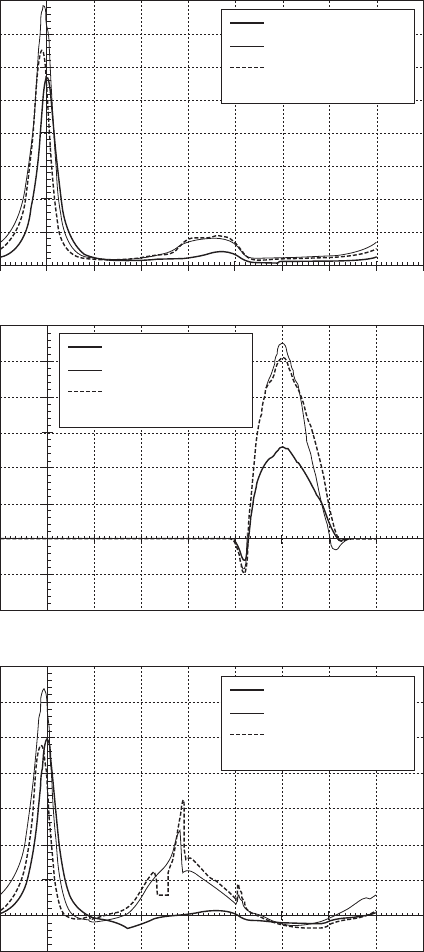
448 Diesel engine system design
© Woodhead Publishing Limited, 2011
Motoring
Bleeder brake
Conventional
compression brake
Motoring
Bleeder brake
Conventional
compression brake
Motoring
Bleeder brake
Conventional
compression brake
–90 0 90 180 270 360 450 540 630 720
Crank angle (degree)
–90 0 90 180 270 360 450 540 630 720
–90 0 90 180 270 360 450 540 630 720
Crank angle (degree)
Intake valve flow rate (one
valve, kg/sec)
Cylinder pressure (bar, absolute)Cylinder heat transfer rate (kW)
80
70
60
50
40
30
20
10
0
70
60
50
40
30
20
10
0
–10
0.30
0.25
0.20
0.15
0.10
0.05
0.00
–0.05
–0.10
Crank angle (degree)
6.21 Performance comparison between conventional compression
brake and bleeder brake at 2000 rpm (instantaneous processes).
Diesel-Xin-06.indd 448 5/5/11 11:50:36 AM
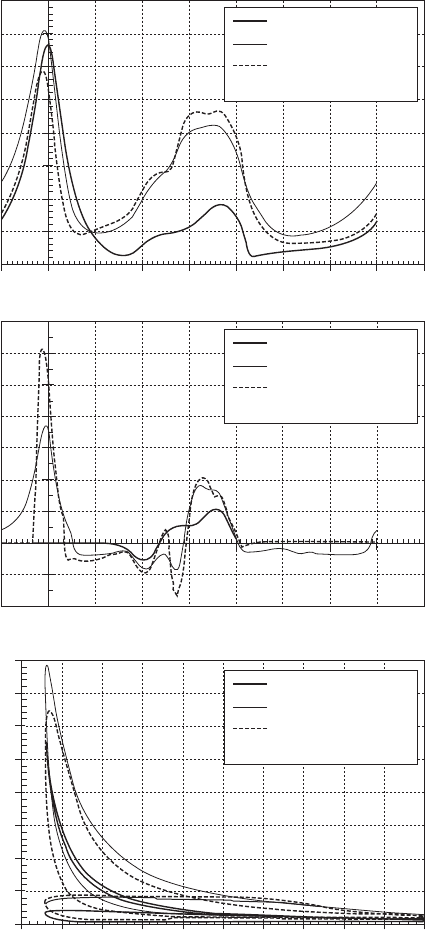
449Engine brake performance in diesel engine system design
© Woodhead Publishing Limited, 2011
Motoring
Bleeder brake
Conventional
compression brake
Motoring
Bleeder brake
Conventional
compression brake
Motoring
Bleeder brake
Conventional
compression brake
–90 0 90 180 270 360 450 540 630 720
Crank angle (degree)
–90 0 90 180 270 360 450 540 630 720
0 0.1 0.2 0.3 0.4 0.5 0.6 0.7 0.8 0.9 1
Instantaneous in-cylinder volume
Cylinder gas temperature (k)
Braking exhaust valve flow rate
(one valve, kg/sec)
Cylinder pressure (bar, absolute)
1100
1000
900
800
700
600
500
400
300
1.4
1.2
1
0.8
0.6
0.4
0.2
0
–0.2
–0.4
80
70
60
50
40
30
20
10
0
Crank angle (degree)
6.21 Continued
Diesel-Xin-06.indd 449 5/5/11 11:50:36 AM

450 Diesel engine system design
© Woodhead Publishing Limited, 2011
6.4.5 Ambient effect on compression brake performance
The air system theory of turbocharged engine performance is discussed in
Chapter 4. Different ambient performance can be explained by the four ‘core
equations’ in Chapter 4. For example, at high altitude, there are basically
two effects that can increase the turbine pressure ratio: a lower turbine outlet
pressure and a higher turbine inlet temperature. The higher temperature results
from the lower air mass ow rate caused by a lower ambient air density.
The increased turbine pressure ratio makes the turbine run at a higher shaft
speed than at sea-level altitude. This partly compensates for the reduced
compressor outlet boost pressure. At a given altitude, hotter ambient air
temperature will reduce the engine air mass ow rate, turbine pressure ratio,
compressor pressure ratio, and hence intake manifold boost pressure.
Engine retarding power depends largely on the intake manifold boost
pressure in the compression-release process. The boost pressure is dependent
on the particular turbocharger used. The effects of ambient temperature,
altitude, and humidity were analyzed by Israel and Hu (1993). Their results
showed that the retarding power decreased slightly as the relative humidity
increased. For example, when the relative humidity changed from 0% to 100%,
the retarding power only changed by 5 kW from 240 kW to 235 kW at 2100
rpm engine speed. This effect is minor compared to the effects caused by the
changes in the ambient temperature and pressure. A formula was proposed
Table 6.1 Retarding performance comparison between conventional compression
brake and bleeder brake
Motoring Conventional
compression
brake
Bleeder
brake
Engine speed (rpm) 2000 2000 2000
Engine retarding power (hp) 79 385 387
LP-stage turbine outlet pressure (bar,
absolute)
1.026 1.111 1.101
Exhaust manifold pressure (bar, absolute) 2.355 5.367 5.020
Intake manifold boost pressure (bar, absolute) 1.199 2.363 2.720
Engine delta P (bar) 1.157 3.004 2.300
Engine air flow rate (lb/min) 29.77 58.81 55.45
Exhaust manifold gas temperature (°F) 338 934 936
Peak cylinder temperature (°F) 1279 1138 1359
Cycle-average cylinder temperature (°F) 334 480 528
one cylinder cycle-average heat transfer rate
(kW)
2.65 5.77 7.41
Diesel-Xin-06.indd 450 5/5/11 11:50:36 AM
451Engine brake performance in diesel engine system design
© Woodhead Publishing Limited, 2011
by Israel and Hu (1993), ignoring the retarding system compliance resulting
from the cylinder pressure, as follows:
ϖ
IMEp,retarding
= – 2.9105T
AMB
+ 11.7884p
AMB
+ C 6.13
where ϖ
IMEp,retarding
is the retarding indicated mean effective pressure (kPa),
T
AMB
is the ambient air temperature (∞C), p
AMB
is the ambient absolute pressure
(kPa), and C is a constant (kPa) dening the absolute level of the retarding
power at a baseline ambient condition. The retarding power decreases with
increasing ambient temperature and altitude. Strictly speaking, this formula is
limited to the particular turbocharger that was used to generate their simulation
results. Israel and Hu (1993) also concluded that the system compliance in
the compression brake, which was affected by the cylinder pressure and
ambient conditions, had a signicant adverse impact on the braking valve
timing and the retarding power, especially at high engine speeds.
6.4.6 Two-stroke braking with compression brakes
As the four-stroke braking power is limited by various design constraints,
innovative two-stroke braking may be considered to increase the power
without violating the design constraints such as the braking assembly
loading. By removing the normal exhaust valve event, the exhaust stroke
in the four-stroke engine cycle becomes a second compression stroke from
which more retarding power can be obtained via the strong compression-
release effect, compared to the low pumping loss during that stroke in the
four-stroke braking. Yang (2002) reported that more than 40% braking power
increase was achieved by using a two-stroke compression brake compared
with the four-stroke brake. More analysis on two-stroke braking is presented
in the next section on the VVA compression brake since VVA is a practical
mechanism to generate two-stroke valve events.
6.4.7 VVA and camless compression brakes
Usually the performance of the conventional compression brake can only
be optimized at a certain engine speed within a narrow range due to the
limitation of the mechanical driving mechanisms involved in the braking
valve motion control. The VVA compression brake with solenoid controls
provides great exibility to optimize the retarding performance at each engine
speed by adjusting the braking valve motion and opening/closing timing
so that the retarding process efciency can be greatly increased across the
entire engine speed range. For example, at higher speeds, an advance of the
braking valve opening timing is required to achieve optimum blow-down
of the cylinder charge and the maximum retarding power. As analyzed by
Hu et al. (1997a), the xed braking valve timing results in a sharp drop in
Diesel-Xin-06.indd 451 5/5/11 11:50:36 AM
452 Diesel engine system design
© Woodhead Publishing Limited, 2011
retarding efciency as the engine speed decreases, and an optimized valve
timing achieved with a VVA at each speed results in a high and constant
retarding efciency of 84% across the entire engine speed range. The VVA
brake can also easily achieve variable retarding power levels to satisfy the
different braking power requirements of the vehicle during driving.
The conventional compression brake usually uses hydraulics added on
top of the engine valvetrain and uses the motion of the injector cam or the
exhaust cam to open one exhaust valve near the compression (braking) TDC.
It introduces extra height and weight. The VVA brake can be much smaller,
lighter (e.g., weight reduced by half) and quieter than the conventional brake.
VVA brake can be less noisy because it can work like a bleeder brake to
exibly adjust the multiple pieces of the braking valve motion during the
engine cycle in order to alter the gas ows through the exhaust valves and
the exhaust pressure wave characteristics.
An integrated lost motion variable-valve-timing (VVT) diesel engine
retarder was introduced by Hu et al. (1997b). A comprehensive simulation
of VVA compression brake systems on performance, hydraulics, CFD, and
nite element structural analysis was elaborated by Schwoerer et al. (2002).
Diesel VVA compression brake performance was also investigated by Israel
(1998) and Fessler and Genova (2004).
A comprehensive simulation analysis of various VVA or camless
compression brakes is presented in Figs 6.22–6.25. Figure 6.22 shows
the engine valve lift proles used in seven different compression brakes,
including both four-stroke and two-stroke brakes, as well as their retarding
performance summary. Figure 6.23 shows the simulated instantaneous
engine intake and exhaust valve ow rates of these brakes. Figure 6.24
shows the engine operating points located on the compressor map for these
brakes. Figure 6.25 presents a comparison between the two-stroke and the
four-stroke compression brakes. It is observed that turbine area and braking
valve opening timing have a signicant impact on the retarding power, and
the two-stroke brake produces much higher retarding power than the four-
stroke brake.
6.4.8 Engine brake noise
The US federal noise regulations effective since 1978 require that all vehicles
meet noise requirements. According to US EPA’s Noise Regulation 40 CFR
Part 205, new trucks made in the US are required to emit less than 80 dBA
of noise at 50-feet-away full-pedal drive-by acceleration. The noise must not
exceed 83 dBA in any operating mode under 35 mph, and it cannot exceed
87 dBA over 35 mph. Some trucks with standard OEM exhaust systems may
produce higher noise levels (e.g., 83 dBA) when certain types of compression
brakes are turned on, compared to their 80 dBA noise during acceleration. A
Diesel-Xin-06.indd 452 5/5/11 11:50:36 AM
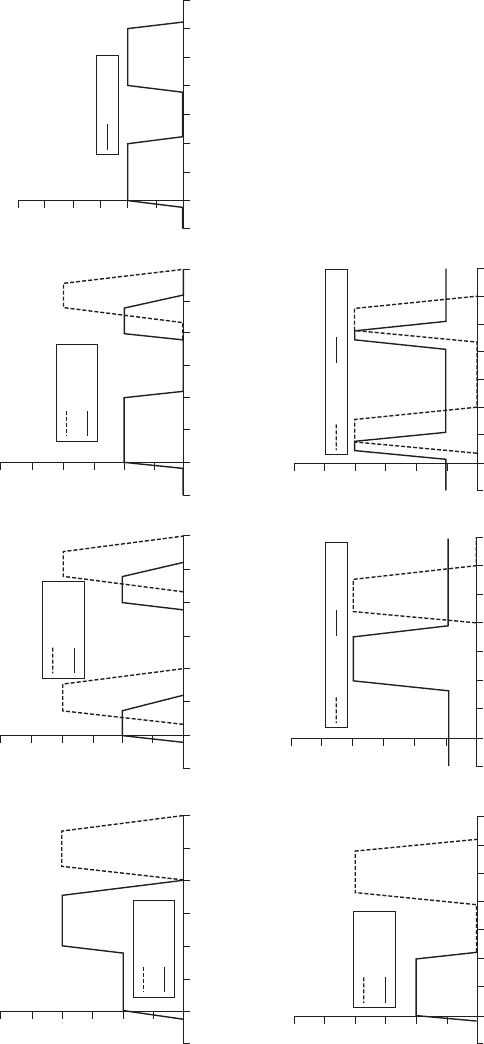
© Woodhead Publishing Limited, 2011
A: 4-stroke compression brake
E: 4-stroke compression brake-2 F: 4-stroke bleeder brake G: 2-stroke bleeder brake
B: 2-stroke compression brake 1 C: 2-stroke compression brake 2
D: 2-stroke compression brake 3
(only for naturally aspirated
engine)
Retarding power: 214 hp
engine flow rate: 864 kg/hr
Compressor surge happens!
Retarding power: 237 hp
engine flow rate: 254 kg/hr
Retarding power: 133 hp
engine flow rate: 547 kg/hr
Retarding power: 222 hp
engine flow rate: 1004 kg/hr
Retarding power: 404 hp
engine flow rate: 1517 kg/hr
Retarding power: 405 hp
engine flow rate: 1134 kg/hr
Retarding power: 143 hp
Intake valve is kept closed.
Exhaust
Intake
Exhaust
Intake
Exhaust
Intake
Exhaust
Intake Exhaust Intake Exhaust
Intake
Exhaust
Valve lift (mm)
Valve lift (mm)
Valve lift (mm)
Valve lift (mm)
Valve lift (mm)
Valve lift (mm)
Valve lift (mm)
6
5
4
3
2
1
0
6
5
4
3
2
1
0
6
5
4
3
2
1
0
6
5
4
3
2
1
0
6
5
4
3
2
1
0
6
5
4
3
2
1
0
6
5
4
3
2
1
0
–90 0 90 180 270 360 450 540
Crank angle (degree)
–90 0 90 180 270 360 450 540
Crank angle (degree)
–90 0 90 180 270 360 450 540
Crank angle (degree)
–90 0 90 180 270 360 450 540 630
Crank angle (degree)
–90 0 90 180 270 360 450 540 630
Crank angle (degree)
–90 0 90 180 270 360 450 540 630
Crank angle (degree)
–90 0 90 180 270 360 450 540 630
Crank angle (degree)
Note: The retarding power
data here were obtained
by using a 9.3L I6 camless
engine with a fixed-geometry
wastegated turbine (except
for the Brake D).
6.22 HD diesel engine camless engine compression brake concept analysis – valve lift and summary.
Diesel-Xin-06.indd 453 5/5/11 11:50:36 AM
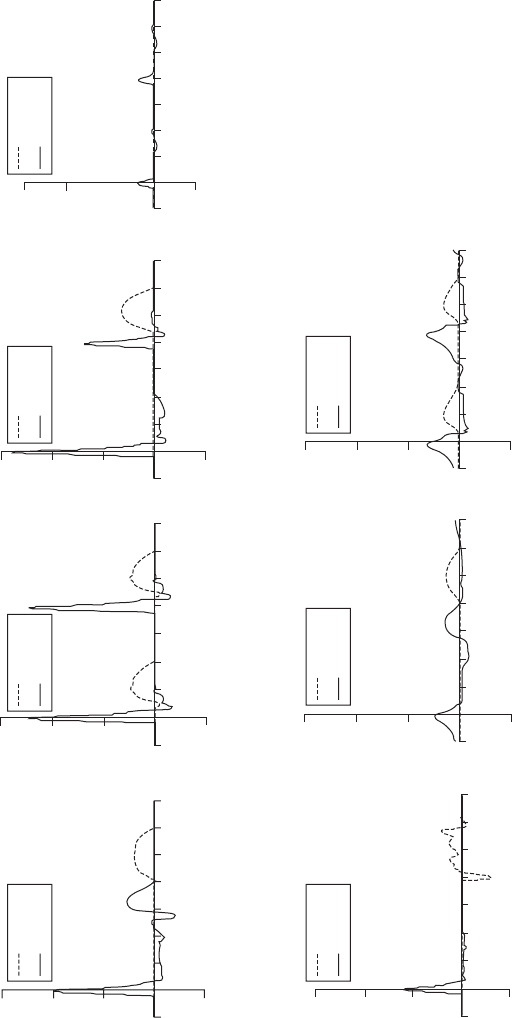
© Woodhead Publishing Limited, 2011
–90 0 90 180 270 360 450 540 630
Crank angle (degree)
–90 0 90 180 270 360 450 540 630
Crank angle (degree)
–90 0 90 180 270 360 450 540 630
Crank angle (degree)
–90 0 90 180 270 360 450 540 630
Crank angle (degree)
–90 0 90 180 270 360 450 540 630
Crank angle (degree)
–90 0 90 180 270 360 450 540 630
Crank angle (degree)
–90 0 90 180 270 360 450 540 630
Crank angle (degree)
A: 4-stroke compression brake
E: 4-stroke compression brake-2 F: 4-stroke bleeder brake G: 2-stroke bleeder brake
B: 2-stroke compression brake 1 C: 2-stroke compression brake 2
D: 2-stroke compression brake 3
(only for naturally aspirated
engine)
Intake
Exhaust
Intake
Exhaust
Intake
Exhaust
Intake
Exhaust
Intake
Exhaust
Intake
Exhaust
Intake
Exhaust
Severe compressor
surge happens!
Valve flow rate (kg/sec)
Valve flow rate (kg/sec)
Valve flow rate (kg/sec)
Valve flow rate (kg/sec)
Valve flow rate (kg/sec)
Valve flow rate (kg/sec)
Valve flow rate (kg/sec)
0.9
0.6
0.3
0
–0.3
0.9
0.6
0.3
0
–0.3
0.9
0.6
0.3
0
–0.3
0.9
0.6
0.3
0
–0.3
0.9
0.6
0.3
0
–0.3
0.9
0.6
0.3
0
–0.3
0.9
0.6
0.3
0
–0.3
6.23 HD diesel engine camless engine compression brake concept analysis – valve flow illustration.
Diesel-Xin-06.indd 454 5/5/11 11:50:37 AM
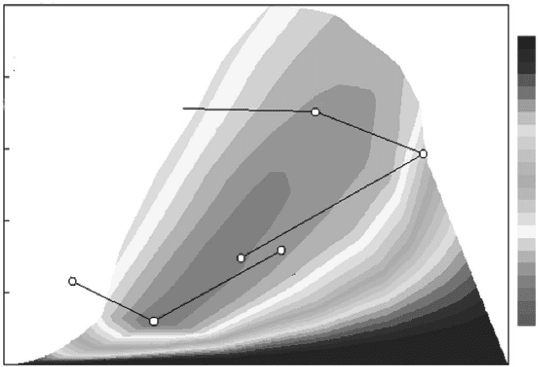
455Engine brake performance in diesel engine system design
© Woodhead Publishing Limited, 2011
truck without an exhaust mufer can produce a much higher noise level such
as 100 dBA noise when the conventional compression brake is turned on.
In the conventional compression brake, the braking valve opens near the
end of the compression stroke where the air is compressed to a very high
pressure. The sudden, almost instantaneous, release of the air creates explosive
pressure pulses in the exhaust manifold, causing a distinctive staccato (loud
popping) braking noise. This effect can be seen from the simulation result
in Fig. 6.26 on the exhaust port pressure pulse waves. It is observed from
Fig. 6.26 that the sharp high-frequency pulse at 10∞ crank angle before the
braking TDC (i.e., –10°) is the reason for the loud noise in the conventional
compression brake. Note that the other sharp pulse wave at 480∞ crank angle
comes from the braking event of another cylinder.
Many truck noise problems on the road are in fact due to defective
mufers or illegal exhaust systems (e.g., an unmufed straight stack). The
braking noise problem is most severe with illegally modied or defective
exhaust systems. The braking noise causes many towns to ban the use of
the conventional compression brake due to serious concerns for the quality
of life in the community. Road signs such as ‘Unmufed engine brake use
prohibited except emergency’ or simply ‘No Engine Brake’ are seen, for
example, near a downhill section of a fast road. In fact, the compression
brake is a valuable legitimate safety device for the vehicle.
Widespread concerns about compression brake noise faced by many local
E
F
(Surge!)
A
C
B
G
0.0000 0.0175 0.0350 0.0525 0.0699 0.0874
Reduced mass flow rate, (kg/s)k
0.5
/kPa
Pressure ratio
3.720
3.176
2.632
2.088
1.544
1.000
Compressor efficiency map and engine brake operating points
MAx: 78.0
MIN: 20.0
EFFIC.
[%]
20.0
30.0
32.5
35.0
37.5
40.0
42.5
45.0
47.5
50.0
52.5
55.0
57.5
60.0
62.5
65.0
67.5
70.0
72.5
75.0
77.5
80.0
82.5
100.0
6.24 HD diesel camless engine compression brake concept analysis –
compressor operating points.
Diesel-Xin-06.indd 455 5/5/11 11:50:37 AM
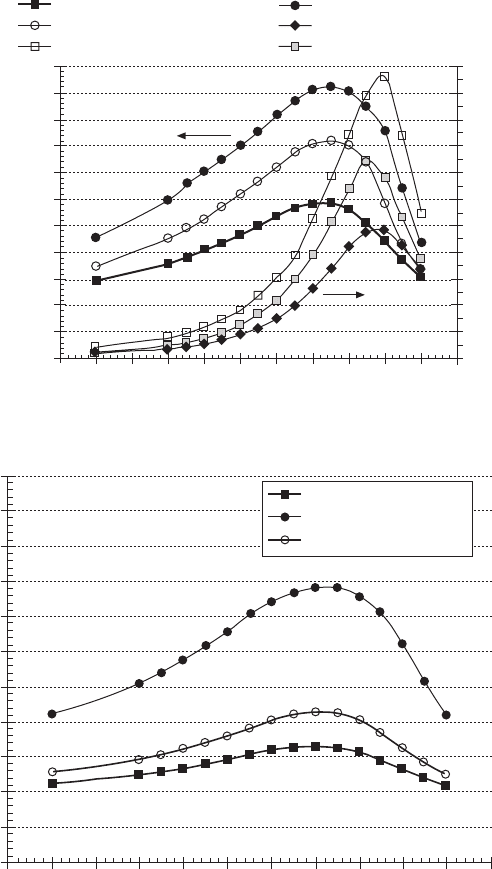
456 Diesel engine system design
© Woodhead Publishing Limited, 2011
2-stroke compression brake simulation (2000 rpm)
Power (VNT vane open) Power (VNT vane closed)
Power (wastegated turbo) Cylinder P (VNT vane open)
Cylinder P (VNT vane closed) Cylinder P (wastegated turbo)
Retarding power (hp)
Retarding power (hp)
550
500
450
400
350
300
250
200
150
100
50
0
550
500
450
400
350
300
250
200
150
100
50
0
–90 –80 –70 –60 –50 –40 –30 –20 –10 0 10 20
EVo timing (degree crank angle)
–90 –80 –70 –60 –50 –40 –30 –20 –10 0 10 20
EVo timing (degree crank angle)
2200
2000
1800
1600
1400
1200
1000
800
600
400
200
0
Cylinder pressure at EVo (psia)
VNT vane fully open
VNT vane fully closed
Wastegated turbine
4-stroke compression brake simulation (2000 rpm)
6.25 Comparison between two-stroke and four-stroke engine
compression brake performance of an I6 engine.
legislation bodies for noise abatement indicate that a quiet compression-release
engine brake design is highly desirable and will offer market competitiveness.
The noise problem can be addressed by more advanced braking mechanism
Diesel-Xin-06.indd 456 5/5/11 11:50:37 AM
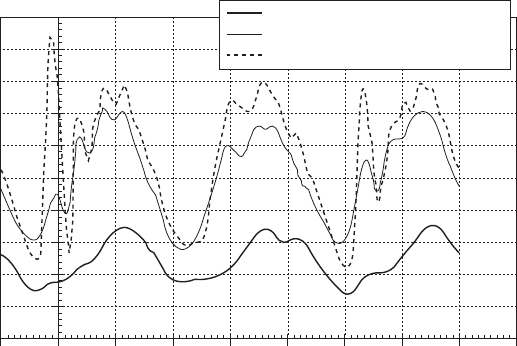
457Engine brake performance in diesel engine system design
© Woodhead Publishing Limited, 2011
and/or effective exhaust mufing. The advanced braking mechanism is
preferred since it controls the noise problem at the source by utilizing better
braking valve events that favorably affect the exhaust gas wave dynamics
in the exhaust manifold and the tailpipe.
Different types of compression brakes produce different levels of noise.
For example, a bleeder brake is quieter than a conventional compression
brake without BGR (e.g., lower by 15 dBA at high engine speeds and 10
dBA at lower speeds). Bleeder or BGR may signicantly reduce the braking
noise due to its different exhaust ow and pressure pulse characteristics
(Fig. 6.26). The noise of exhaust-pulse compression brake stays between
the conventional brake and the bleeder brake, depending on its particular
braking valve lift proles. The noise of the conventional compression brake
decreases as the engine speed decreases. The speed-dependency of the noise
for the bleeder brake is much weaker (i.e., basically equally quiet at all
speeds). Progressive braking using fewer cylinders also reduces the noise.
It should be noted that the exhaust brake and the driveline brakes are nearly
silent, and their noise levels are usually no louder than the plain engine
noise. Schmitz et al. (1992) conrmed that their bleeder brake was more
silent than the conventional brake. Schmitz et al. (1994) also reported that
the use of a small decompression valve and throttling by a narrow overow
duct connected to the exhaust manifold reduced the compression brake
noise, compared to using the larger exhaust valve as the braking valve in
the compression brake.
Motoring
Bleeder brake
Conventional compression brake
–90 0 90 180 270 360 450 540 630 720
Crank angle (degree)
Cylinder-1 exhaust port pressure (bar, absolute)
10
9
8
7
6
5
4
3
2
1
0
6.26 Root cause of engine brake noise – simulation of exhaust
pressure pulses of different engine brakes (2000 rpm).
Diesel-Xin-06.indd 457 5/5/11 11:50:37 AM
